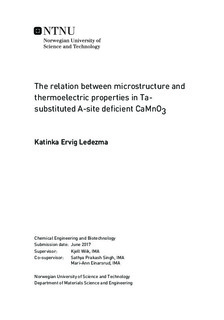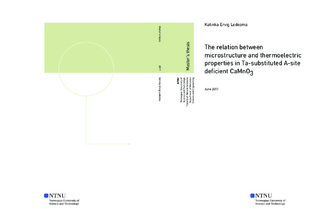| dc.description.abstract | Calcium manganite, CaMnO3, is an n-type semiconductor with promising thermoelectric (TE) properties. However, for commercial applications the performance of the material, described by the thermoelectric figure of merit (zT), needs to be enhanced. In this study, Mn is substituted with 2% Ta (donor doping) to significantly increase the electrical conductivity, whereas the overall composition is Ca-deficient to promote exsolution of a secondary phase, resulting in the composition Ca(0.931)Mn(0.98)Ta(0.02)O(3-delta)(CMTO). This nanosized powder was spark plasma sintered (SPS) in its reduced rock-salt phase of CaO-MnO(ss) between 850°C and 1250°C, and then annealed in air at 1100°C to obtain the oxidized phase of CMTO with the secondary phase CaMn2O4 (marokite). Structural and thermoelectric properties of the material were investigated in order to determine correlations between material's microstructure, composition and TE properties.
Sintering resulted in dense samples with 98% of the theoretical density even at 850°C, and increasing grain size with increasing sintering temperature. After annealing in air, relative density of 95% was obtain. In addition, significant grain growth was observed in the samples sintered at the lowest temperatures, and estimated grain sizes were between 600 nm and 1.9 µm. In addition to the secondary phase, marokite, a third Ta-rich phase (CaTa2O6) was observed.
Increasing amount of marokite resulted in a significant reduction in electrical conductivity, as a result of marokite's insulating behaviour. Consequently, the absolute value of the Seebeck coefficient increased. The secondary phase lowered the thermal conductivity. However, high thermal conductivity was obtained as the grains were large. Nanosized grains enhance the phonon scattering at grain boundaries and a reduction of thermal conductivity with reduced grain size is anticipated. Due to grains in the micrometer range, this effect was not observed.
High thermal conductivity in combination with low electrical conductivity resulted in relatively low zT, with highest value of 0.028 at 900°C. From investigated samples, the one sintered at 850°C is most promising, and improved results are achievable if the amount of marokite is reduced and the annealing temperature lowered. | |

